Thermal Fluctuation Characteristics around a Nanosecond Pulsed Dielectric Barrier Discharge Plasma Actuator using a Frequency Analysis based on Schlieren Images
Abstract
:1. Introduction
2. Experimental Setup and Diagnostics
2.1. Experimental Model
2.2. Schlieren Photography
2.3. Frequency Analysis Based on Schlieren Images
3. Results and Discussions
3.1. Flow Visualisation
3.2. Frequency Analysis Based on the Schlieren Images
4. Conclusions
Author Contributions
Funding
Conflicts of Interest
References
- Erfani, R.; Zare-Behtash, H.; Hale, C.; Kontis, K. Development of DBD plasma actuators: The double encapsulated electrode. Acta Astronaut 2015, 109, 132–143. [Google Scholar] [CrossRef] [Green Version]
- Forte, M.; Jolibois, J.; Pons, J.; Moreau, E.; Touchard, G.; Cazalens, M. Optimization of a dielectric barrier discharge actuator by stationary and non-stationary measurements of the induced flow velocity: Application to airflow control. Exp. Fluids 2007, 43, 917–928. [Google Scholar] [CrossRef]
- Borghi, C.A.; Cristofolini, A.; Neretti, G.; Seri, P.; Rossetti, A.; Talamelli, A. Duty cycle and directional jet effects of a plasma actuator on the flow control around a NACA0015 airfoil. Meccanica 2017, 52, 3661–3674. [Google Scholar] [CrossRef]
- Opaits, D.F.; Likhanskii, A.V.; Neretti, G.; Zaidi, S.; Shneider, M.N.; Miles, R.B.; Macheret, S.O. Experimental investigation of dielectric barrier discharge plasma actuators driven by repetitive high-voltage nanosecond pulses with dc or low frequency sinusoidal bias. J. Appl. Phys. 2008, 104, 043304. [Google Scholar] [CrossRef]
- Benard, N.; Moreau, E. Electrical and mechanical characteristics of surface AC dielectric barrier discharge plasma actuators applied to airflow control. Exp. Fluids 2014, 55, 1846. [Google Scholar] [CrossRef] [Green Version]
- Benard, N.; Note, P.; Caron, M.; Moreau, E. Highly time-resolved investigation of the electric wind caused by surface DBD at various ac frequencies. J. Electrostat. 2017, 88, 41–48. [Google Scholar] [CrossRef]
- Komuro, A.; Takashima, K.; Konno, K.; Tanaka, N.; Nonomura, T.; Kaneko, T.; Ando, A.; Asai, K. Schlieren visualization of flow-field modification over an airfoil by near-surface gas-density perturbations generated by a nanosecond-pulse-driven plasma actuator. J. Phys. D Appl. Phys. 2017, 50, 215202. [Google Scholar] [CrossRef]
- Aono, H.; Sekimoto, S.; Sato, M.; Yakeno, A.; Nonomura, T.; Fujii, K. Computational and experimental analysis of flow structures induced by a plasma actuator with burst modulations in quiescent air. Mech. Eng. J. 2015, 12, 15-00233. [Google Scholar] [CrossRef] [Green Version]
- Benard, N.; Jolibois, J.; Moreau, E. Lift and drag performances of an axisymmetric airfoil controlled by plasma actuator. J. Electrostat. 2009, 67, 133–139. [Google Scholar] [CrossRef]
- Göksel, B.; Greenblatt, D.; Rechenberg, I.; Nayeri, C.N.; Paschereit, C.O. Steady and unsteady plasma wall jets for separation and circulation control. In Proceedings of the 3rd AIAA Flow Control Conference, San Francisco, CA, USA, 5–8 June 2006; AIAA paper 2006-3686. American Institute of Aeronautics and Astronautics: Reston, VA, USA, 2006. [Google Scholar]
- Greenblatt, D.; Göksel, B.; Rechenberg, I.; Schüle, C.Y.; Romann, D.; Paschereit, C.O. Dielectric barrier discharge flow control at very low flight Reynolds numbers. AIAA J. 2008, 46, 1528–1541. [Google Scholar] [CrossRef]
- Roupassov, D.V.; Nikipelov, A.A.; Nudnova, M.M.; Starikovskii, A.Y. Flow separation control by plasma actuator with nanosecond pulsed-periodic discharge. AIAA J. 2009, 47, 168–185. [Google Scholar] [CrossRef]
- Sekimoto, S.; Nonomura, T.; Fujii, K. Burst-mode frequency effects of dielectric barrier discharge plasma actuator for separation control. AIAA J. 2017, 55, 1385–1392. [Google Scholar] [CrossRef]
- Russell, A.; Zare-Behtash, H.; Kontis, K. Joule heating flow control methods for high-speed flows. J. Electrost. 2016, 80, 34–68. [Google Scholar] [CrossRef] [Green Version]
- Knight, D. A short review of microwave and laser discharges for supersonic flow control. J. Aerosp. Lab 2015, 10, AL10-02. [Google Scholar]
- Knight, D. Survey of aerodynamic drag reduction at high speed by energy deposition. J. Propul. Power 2008, 24, 1153–1167. [Google Scholar] [CrossRef]
- Ukai, T.; Kontis, K.; Yang, L. Flow structure generated by laser-induced blast wave propagation through the boundary layer of a flat plate. Aerosp. Sci. Technol. 2018, 78, 569–573. [Google Scholar] [CrossRef] [Green Version]
- Osuka, T.; Erdem, E.; Hasegawa, N.; Majima, R.; Tamba, T.; Yokota, S.; Sasoh, A.; Kontis, K. Laser energy deposition effectiveness on shock-wave boundary-layer interactions over cylinder-flare combinations. Phys. Fluids 2014, 26, 096103. [Google Scholar] [CrossRef]
- Russell, A.; Myokan, M.; Bottini, H.; Sasoh, A.; Zare-Behtash, H.; Kontis, K. Application of laser energy deposition to improve performance for high speed intakes. Propuls. Power Res. 2019. accepted. [Google Scholar] [CrossRef]
- Kinefuchi, K.; Starikovskiy, A.Y.; Miles, R.B. Numerical investigation of nanosecond pulsed plasma actuators for control of shock-wave/boundary-layer separation. Phys. Fluids 2018, 30, 106105. [Google Scholar] [CrossRef] [Green Version]
- Ukai, T.; Russell, A.; Zare-Behtash, H.; Kontis, K. Temporal variation of the spatial density distribution above a nanosecond pulsed dielectric barrier discharge plasma actuator in quiescent air. Phys. Fluids 2018, 30, 116106. [Google Scholar] [CrossRef]
- Komuro, A.; Ogura, N.; Ito, M.; Nonomura, T.; Asai, K.; Ando, A. Visualization of density variations produced by alternating-current dielectric-barrier-discharge plasma actuators using the background-oriented schlieren method. Plasma Sources Sci. Technol. 2019, 28, 055002. [Google Scholar] [CrossRef]
- Schlichting, H.; Gersten, K. Boundary Layer Theory, 8th ed.; Springer: Berlin/Heidelberg, Germany, 2000; pp. 419–424. [Google Scholar]
- Correale, G.; Michelis, T.; Ragni, D.; Kotsonis, M.; Scarano, F. Nanosecond-pulsed plasma actuation in quiescent air and laminar boundary layer. J. Phys. D Appl. Phys. 2014, 47, 105201. [Google Scholar] [CrossRef]
- Ullmer, D.; Peschke, P.; Terzis, A.; Ott, P.; Weigand, B. Impact of ns-DBD plasma actuation on the boundary layer transition using convective heat transfer measurements. J. Phys. D Appl. Phys. 2015, 48, 365203. [Google Scholar] [CrossRef]
- Wojewodka, M.M.; White, C.; Ukai, T.; Russell, A.; Kontis, K. Pressure dependency on a nanosecond pulsed dielectric barrier discharge plasma actuator. Phys. Plasmas 2019, 26, 063512. [Google Scholar] [CrossRef] [Green Version]
- Dawson, R.A.; Little, J. Effects of pulse polarity on nanosecond pulse driven dielectric barrier discharge plasma actuators. J. Appl. Phys. 2014, 115, 043306. [Google Scholar] [CrossRef]
- Cooley, J.W.; Tukey, J.W. An algorithm for the machine computation of the complex Fourier series. Math. Comput. 1965, 19, 297–301. [Google Scholar] [CrossRef]
- Tamba, T.; Pham, H.S.; Shoda, T.; Iwakawa, A.; Sasoh, A. Frequency modulation in shock wave-boundary layer interaction by repetitive-pulse laser energy deposition. Phys. Fluids 2015, 27, 091704. [Google Scholar] [CrossRef]
- Frigo, M.; Johnson, S.G. FFTW: An adaptive software architecture for the FFT. In Proceedings of the IEEE International Conference on Acoustics, Speech and Signal, Seattle, WA, USA, 15 May 1998; pp. 1381–1384. [Google Scholar]
- Zhao, Z.; Li, J.M.; Zheng, J.; Cui, Y.D.; Khoo, B.C. Study of shock and induced flow dynamics by nanosecond dielectric-barrier-discharge plasma actuators. AIAA J. 2015, 53, 1336–1348. [Google Scholar] [CrossRef]
- Takashima, K.; Zuzeek, Y.; Lempert, W.R.; Adamovich, I.V. Characterization of a surface dielectric barrier discharge plasma sustained by repetitive nanosecond pulses. Plasma Sources Sci. Technol. 2011, 20, 055009. [Google Scholar] [CrossRef]
- Dawson, R.; Little, J. Characterization of nanosecond pulse driven dielectric barrier discharge plasma actuators for aerodynamic flow control. J. Appl. Phys. 2013, 113, 103302. [Google Scholar] [CrossRef]
- Versailles, P.; Gingras-Gosselin, V.; Vo, H.D. Impact of pressure and temperature on the performance of plasma actuators. AIAA J. 2010, 48, 859–863. [Google Scholar] [CrossRef]
- Erfani, R.; Zare-Behtash, H.; Kontis, K. Plasma actuator: Influence of dielectric surface temperature. Exp. Therm. Fluid Sci. 2012, 42, 258–264. [Google Scholar] [CrossRef] [Green Version]
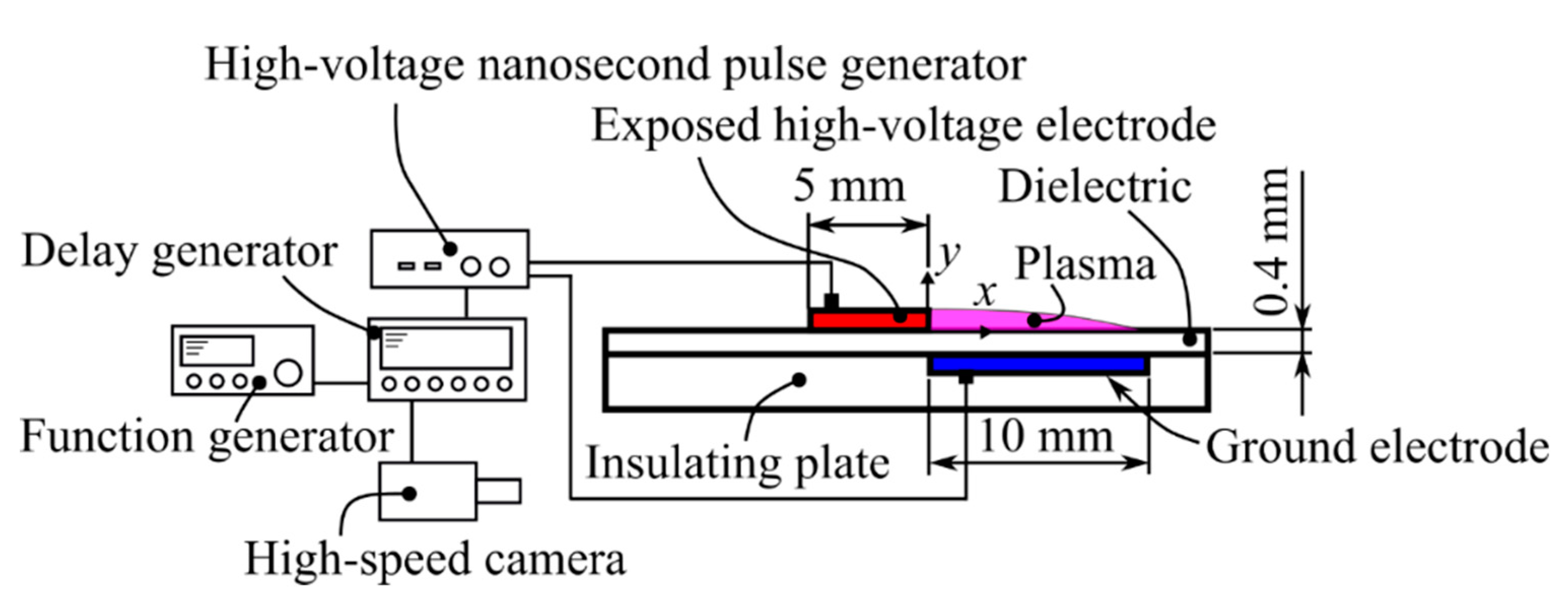
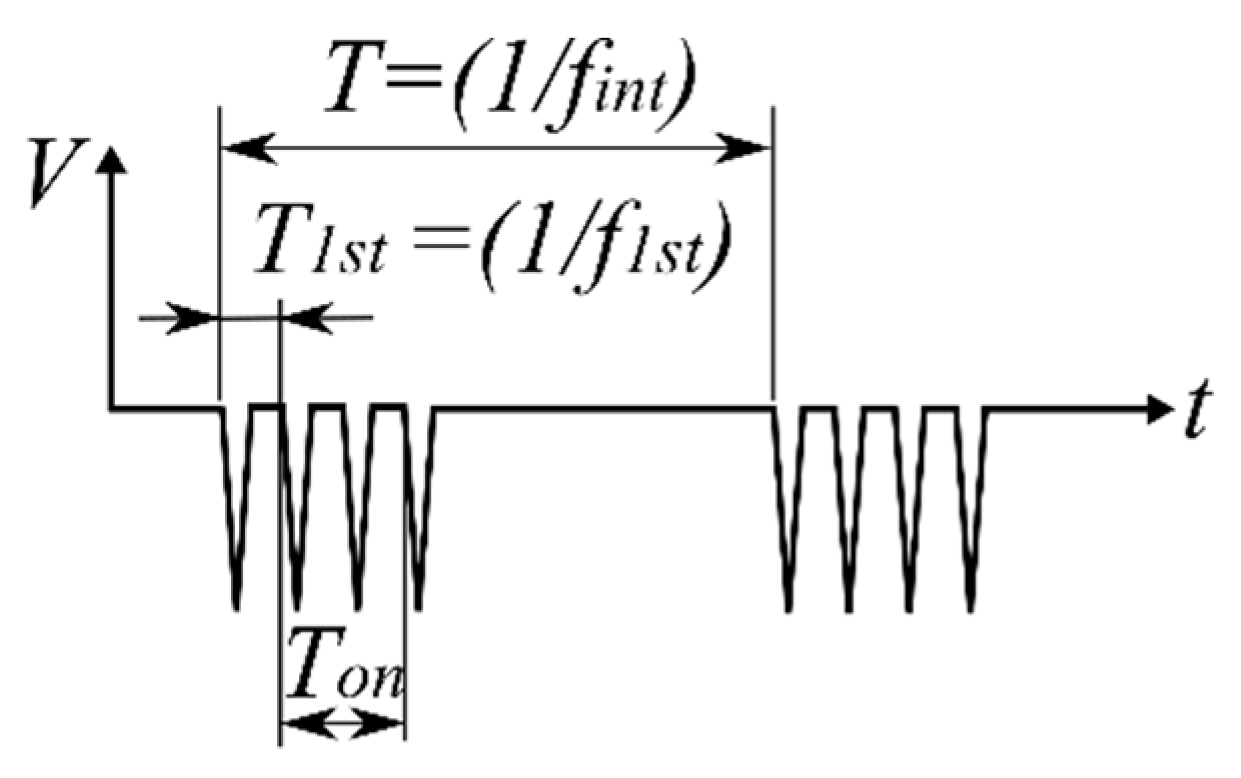
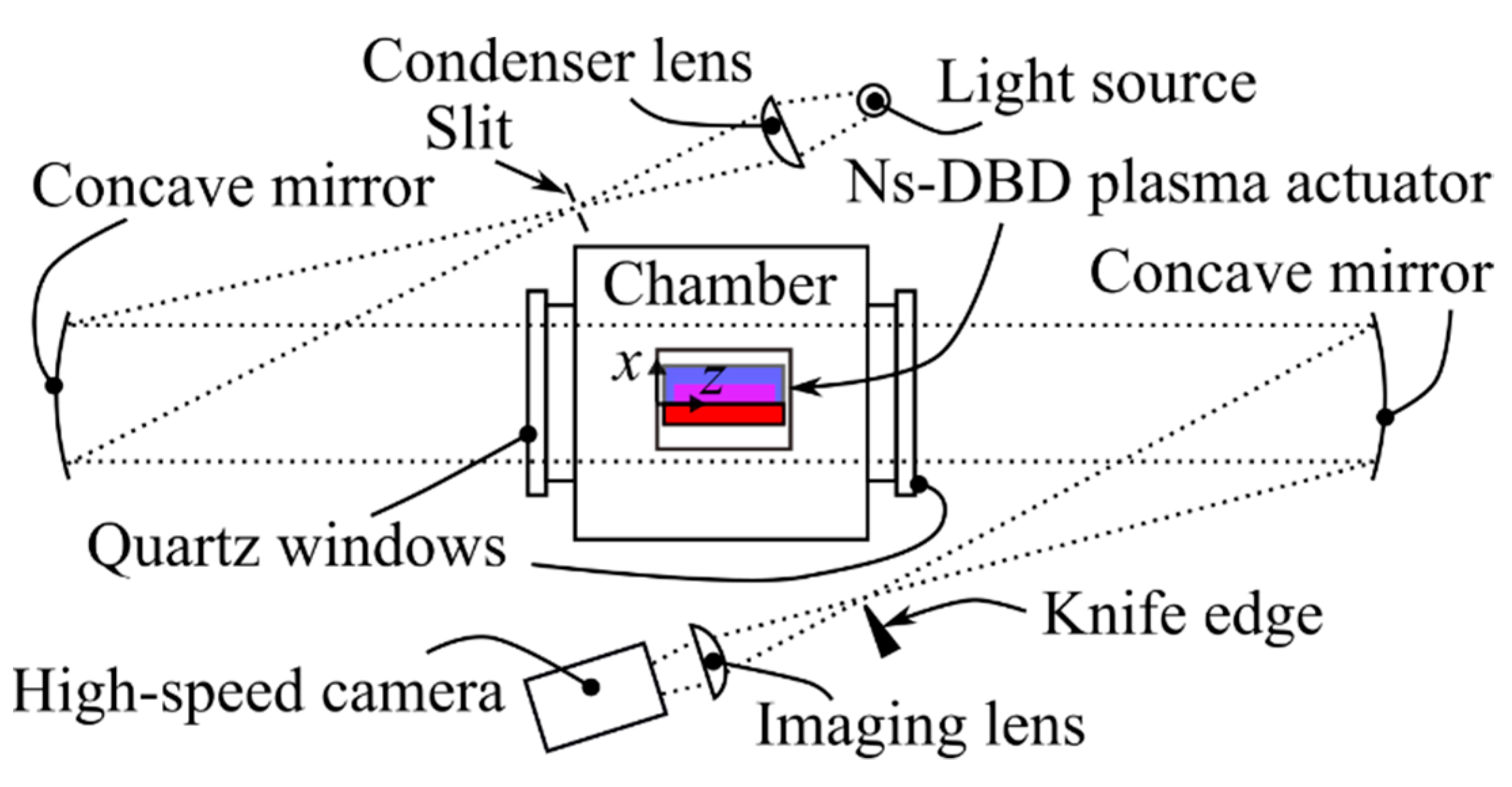
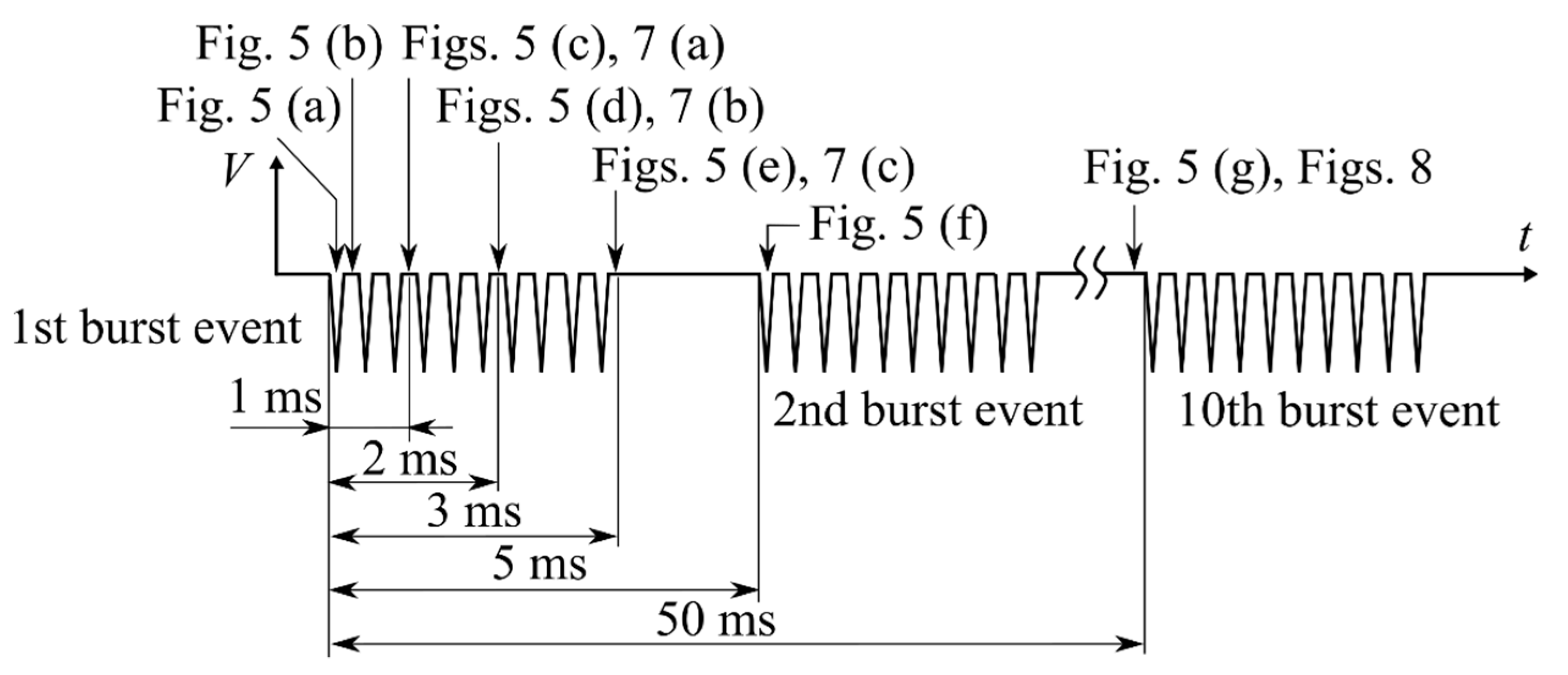
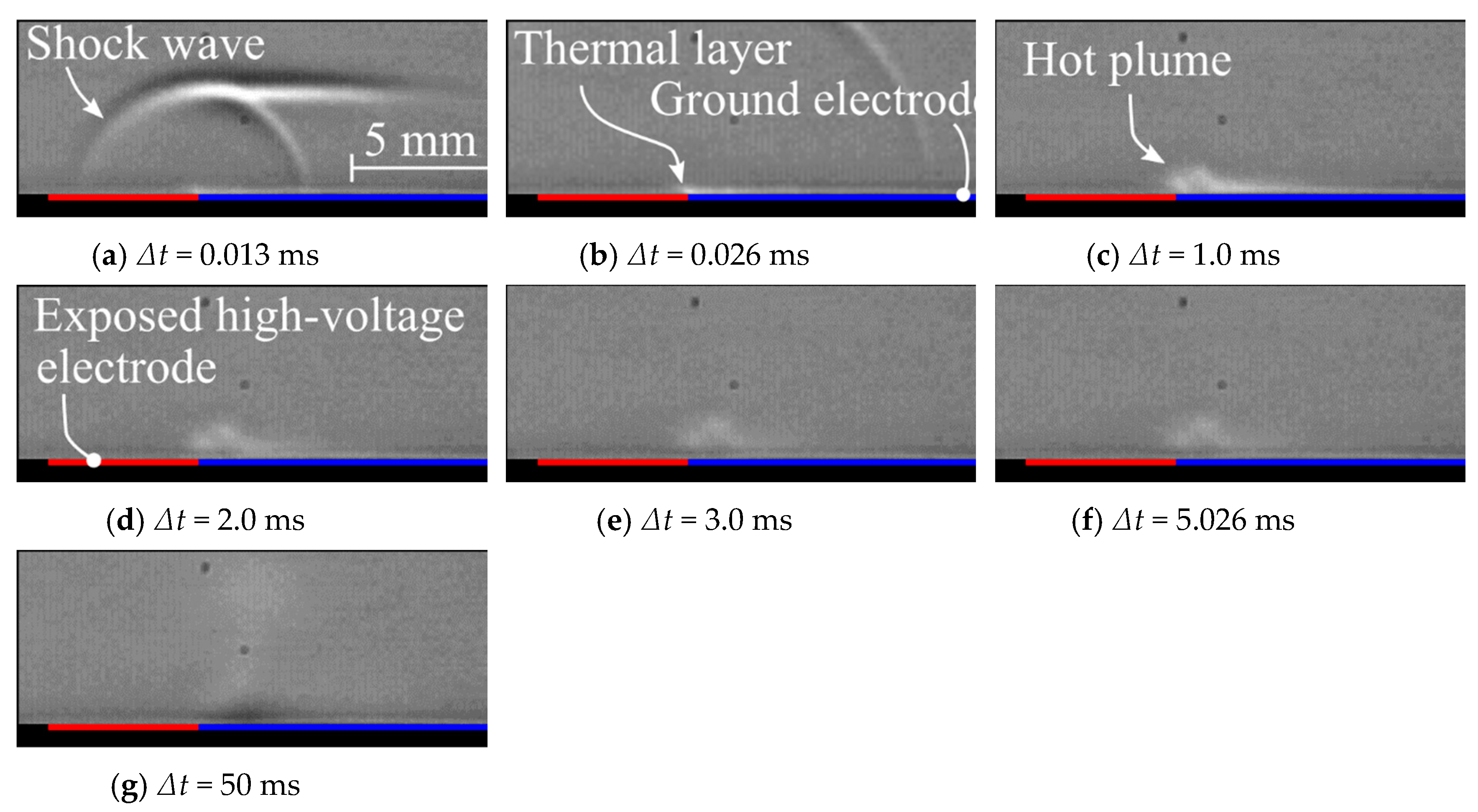




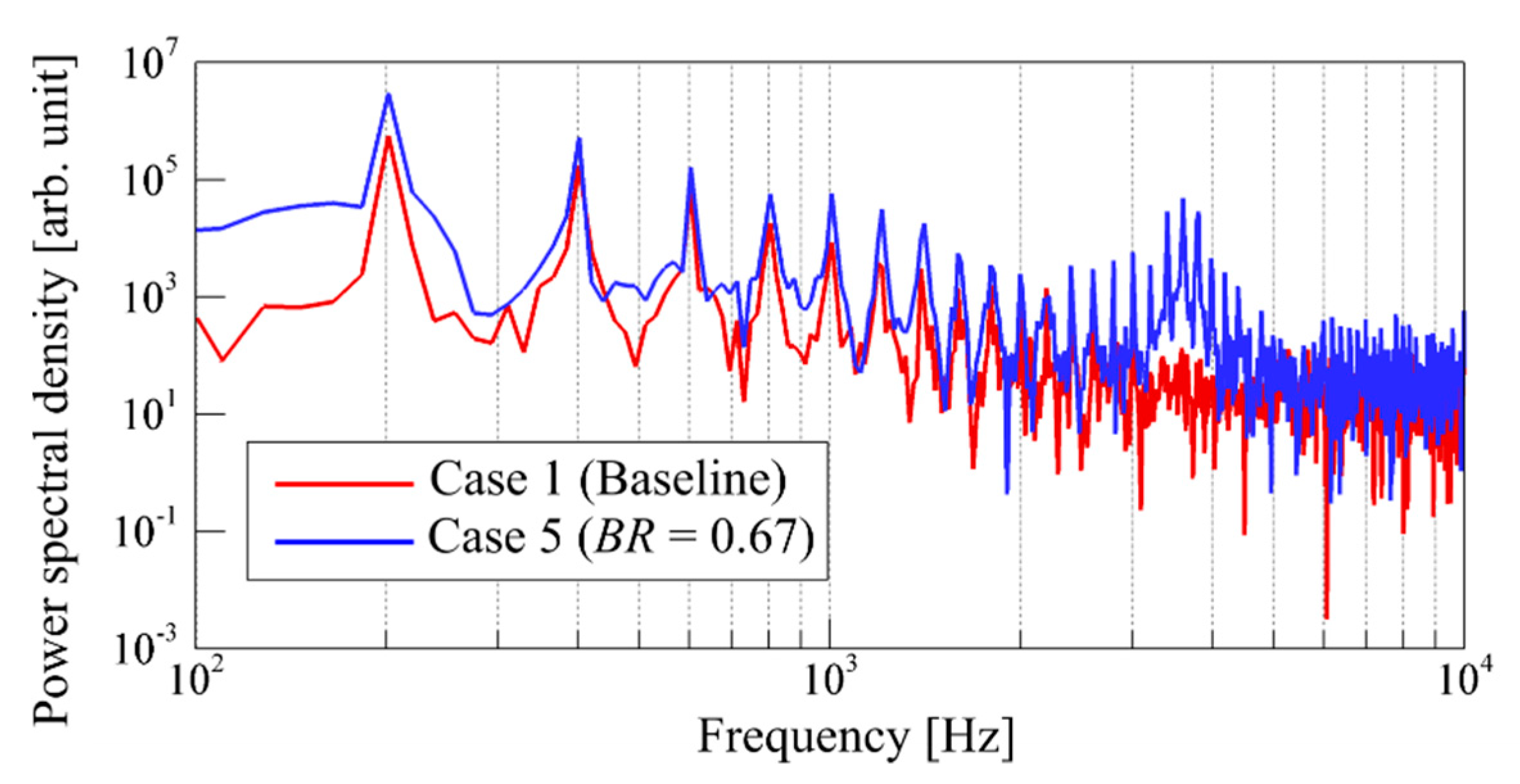



| Case | Plasma Pulse Number Per Burst Event | BR = Ton/T |
|---|---|---|
| 1 | 1 | - |
| 2 | 4 | 0.23 |
| 3 | 6 | 0.34 |
| 4 | 8 | 0.45 |
| 5 | 10 | 0.57 |
© 2020 by the authors. Licensee MDPI, Basel, Switzerland. This article is an open access article distributed under the terms and conditions of the Creative Commons Attribution (CC BY) license (http://creativecommons.org/licenses/by/4.0/).
Share and Cite
Ukai, T.; Kontis, K. Thermal Fluctuation Characteristics around a Nanosecond Pulsed Dielectric Barrier Discharge Plasma Actuator using a Frequency Analysis based on Schlieren Images. Energies 2020, 13, 628. https://doi.org/10.3390/en13030628
Ukai T, Kontis K. Thermal Fluctuation Characteristics around a Nanosecond Pulsed Dielectric Barrier Discharge Plasma Actuator using a Frequency Analysis based on Schlieren Images. Energies. 2020; 13(3):628. https://doi.org/10.3390/en13030628
Chicago/Turabian StyleUkai, Takahiro, and Konstantinos Kontis. 2020. "Thermal Fluctuation Characteristics around a Nanosecond Pulsed Dielectric Barrier Discharge Plasma Actuator using a Frequency Analysis based on Schlieren Images" Energies 13, no. 3: 628. https://doi.org/10.3390/en13030628





